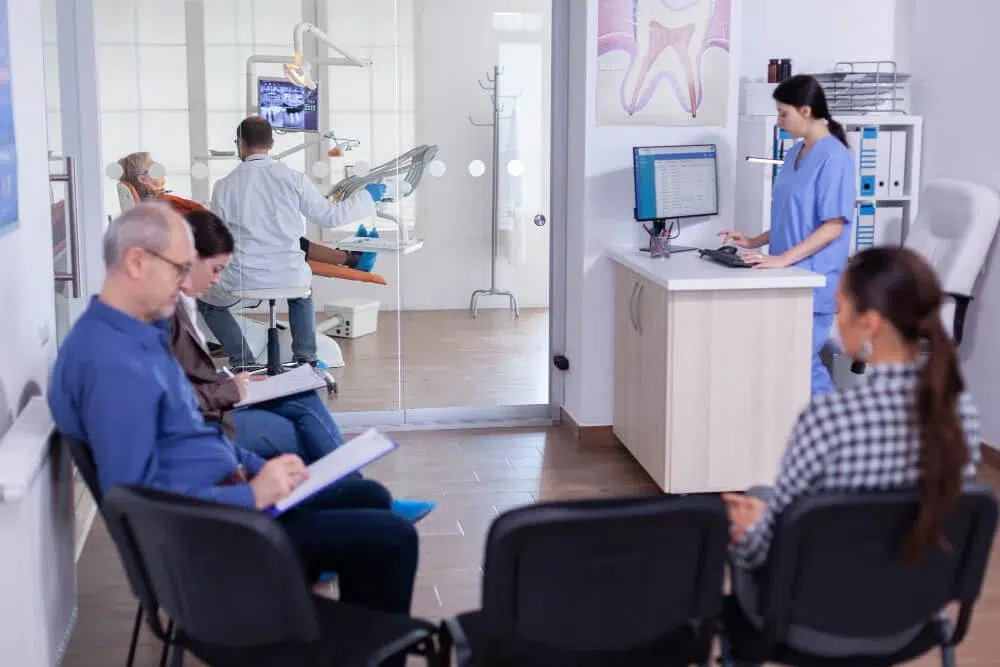8 Patient Scheduling Best Practices for Medical Offices

Discover the top 8 patient scheduling best practices to optimize your medical office operations and improve patient satisfaction.
Patient scheduling is one of the most essential elements of effective practice management in the healthcare industry.
While patient wait times have been a long-standing concern for medical providers, your medical center should focus on improving your patient scheduling processes as healthcare providers continue to see a rise in patient consumerism.
Now more than ever, patient scheduling procedures can cause friction between providers and patients, as patients are no longer content visiting a facility with long wait times with many other available options.
If your medical office has long wait times, you may find it hard to attract and retain patients. Because of this, your medical practice must innovate and explore ways to maximize revenue and productivity without sacrificing patient satisfaction.
It’s important to keep your medical center’s schedule consistently full (with minimal no-shows) without overbooking yourself to ensure maximum productivity without excessive wait times.
While this may seem like an impossible task, there are steps that you can take to improve scheduling efficiency. Here’s a look at patient scheduling best practices we’ve used to boost productivity and improve patient satisfaction at healthcare centers across the US.
8 patient scheduling best practices in 2024
Implement these eight tips to improve patient scheduling, lower patient no-shows, and optimize your medical center’s operations.
1. Send text and email appointment reminders
If you have not done so already, implementing an automated appointment reminder system is critical in order to minimize the number of no-shows. An appointment reminder system will text, email, or call patients at set intervals before their appointment.
When you send reminders to your patients, make sure you include:
- Physician’s name
- Appointment time and date
- Location
- Necessary steps to take before the appointment (such as fasting or drinking liquids)
Using text and email appointment reminders for your patients can drastically improve confirmation rates while reducing missed appointments and late arrivals.
Multi-channel appointment reminders can also be helpful to use a two-way reminder system that allows patients to respond to texts or emails to quickly and efficiently confirm, cancel, or reschedule appointments. Such systems improve customer satisfaction and make it easier for patients to control their appointments, improving the likelihood that they will show up on time.
2. Outsource to a healthcare call center
As our world becomes increasingly digital, an obvious way to modernize patient scheduling is to provide 24/7 scheduling services. Allowing patients to schedule and reschedule appointments with as little friction as possible can provide various benefits to your patients and your practice.
By outsourcing support services to a healthcare call center, you can:
- Save costs with an outsourced provider
- Schedule according to seasonal demand and fluctuations
- Expand your customer services to cover more hours each day
- Increase operational efficiency with business intelligence
Using a healthcare call center can also help maximize revenue, as 26% of appointments made online are for same-day or next-day slots. This can help fill your schedule gaps, ensuring you are always busy.
Having the ability to self-schedule appointments can also boost customer satisfaction. For medical centers that struggle to keep overhead costs down while providing timely, satisfactory patient support, the scalability and efficiency of a call center can alleviate your pain.
3. Prioritize appointments
Patient visit lengths can vary greatly, depending on the level of care needed.
To ensure you don’t over- or under-book your medical office and that you don’t have unreasonable wait times, you should prioritize appointments during patient scheduling. Considering the level of care a patient may need based on the reason for their visit is critical and should influence where place patients, and how much time their visits should be.
You should also consider using this time to decide if a patient needs to be placed on the schedule. A minor issue, such as needing medication refilled, may be handled by a nurse or doctor via a short phone consultation.
This approach can help increase patient satisfaction by making it more convenient for patients with more minor, marginal issues while ensuring that in-person appointments are reserved for patients needing in-person care.
By prioritizing appointments, you can save time and resources for your practice and fill your in-person schedule with revenue-producing appointments. This can also boost patient satisfaction by saving patients the time they would have spent driving to and waiting in your office.
4. Implement a strategic patient scheduling process
Unfortunately, even your best efforts cannot prevent late cancellations and no-shows entirely. However, you can help mitigate cancellations and no-shows’ effect on your practice by double-booking patients with a high possibility of not showing up and maintaining a waitlist of patients who would like to get in earlier than their currently scheduled appointment.
When minimizing downtime at your medical center, you can use predictive analytics and machine learning to pinpoint at-risk patients and then double-book. Examine patient no-show history to identify which appointment slots and patients are at risk of missing appointments.
CCD’s Business Intelligence department found that patients with at least one previous no-show are 16x more likely to miss another appointment. Just as airlines double-book seating, doing so at your medical offices can help prevent downtime and idle resources during your daily schedules.
If you decide to implement a patient waitlist, you can implement a patient scheduling system that provides you with the ability to send out a mass text to patients on your waitlist notifying them of your immediate open slot. This can save you a lot of time by quickly notifying a large group of patients of the availability and prompting them to call you rather than you calling patients one-by-one.
5. Automate your patient recalls
Having a patient recall system in place that sends patients a text or email notifying them when it’s time to make another appointment helps ensure rechecks while keeping your schedule fuller.
When used in conjunction with a self-scheduling system, automated patient recalls help your patients easily stay on top of their exams and necessary appointments.
Instead of sending out appointment reminder cards that easily get lost or forgotten, a reminder text or email that includes a link that lets patients self-schedule an appointment will keep patients on track while helping to consistently fill gaps in your schedule.
6. Use staff more efficiently
When medical centers experience fluctuating demand depending on the time of day, week, or even year, it’s hard to ensure that your staff is being fully utilized and productive. Medical centers looking to improve patient wait times and make scheduling easier is to ensure that you’re utilizing your staff as efficiently as possible.
If it seems as though your physicians are overwhelmed, and patients are constantly complaining about long wait times, you should consider whether there are ways in which you could increase your care team’s capacity to reduce your physicians’ burden.
For instance, could a nurse review patient instructions for medications and follow-up care at the end of the appointment? If this is something your physicians are currently doing, allowing this task to be handled by a nurse would let your physician move on to their next appointment. Ensuring your office runs as efficiently as possible can help relieve scheduling problems.
7. Standardize your processes and systems
Standardization is key to scaling your appointment scheduling and support services. When you streamline your appointment scheduling workflows, consider how you can templatize your scheduling templates, appointment urgency, and entire workflow from appointment scheduling to follow-up.
When scheduling patients at your outpatient medical centers, here are a few things to keep in mind.
Initial patient information to collect includes |
Appointment information for first and subsequent calls: |
|
|
What your calendar should look like:
- Tab for calendar dates
- Color code the booked appointments by the name of a doctor
- Include information such as appointment type, level of urgency, and patient information
Any changes made to internal patient scheduling processes must be communicated to all parties involved and documented in your internal knowledge base.
8. Introduce a queuing system
When patients cancel an appointment, an automated queuing system displays real-time available slots to other customers trying to book an appointment.
By doing this, you can decrease walkaway times and missed appointments, wait times, and patient complaints–helping you to utilize your resources better, improve patient satisfaction, and optimize your schedule management.
Why efficient scheduling matters in medical offices
Efficient scheduling ensures that patient flow through the medical office is smooth and well-managed. This means reducing long waiting times, which can lead to patient dissatisfaction and anxiety. When patients are seen promptly, it enhances their overall experience and trust in the medical facility.
Through efficient scheduling, healthcare centers gain:
Enhanced communication
Efficient scheduling enables medical professionals to allocate more time for patient interactions. This fosters better communication between doctors and patients, allowing for a more thorough understanding of medical conditions and treatment plans.
Improved patient satisfaction
Long wait times and crowded waiting areas can add to patients’ stress. By scheduling appointments efficiently, medical offices can create a more relaxed and comfortable patient environment, contributing to better health outcomes.
Low burnout
Efficient scheduling prevents overworking staff, reducing the risk of burnout. Burnout can have a detrimental impact on the quality of care provided. Medical offices can maintain a motivated and dedicated team by ensuring reasonable work hours.
Improved work-life balance
Doctors and nurses also have personal lives that require attention. Efficient scheduling allows for a better work-life balance, leading to more content and focused medical professionals.
Lower your patient no-show rates
Ultimately, there is an art to patient scheduling, and it may take some time to find the perfect balance to ensure you maximize productivity while minimizing wait times. Feel free to Request a Consultation for more advice on patient scheduling best practices, and make sure to download our guide on reducing patient no-shows.
These eight steps can make your staff and patients’ lives easier. Improve the overall care and quality available in your facility and provide the best patient care possible. To learn more about improving the patient experience and satisfaction through excellent care, read our blog on decreasing patient no-shows through machine learning.





